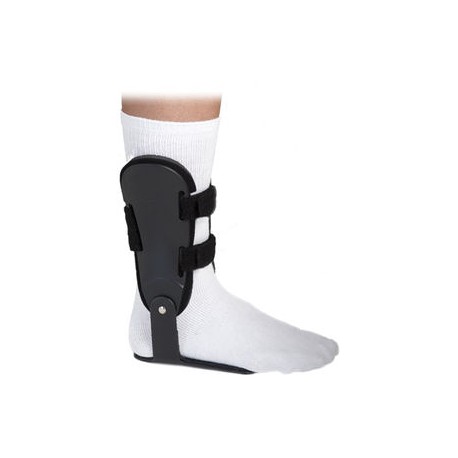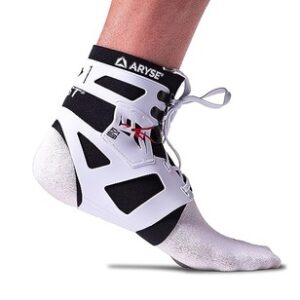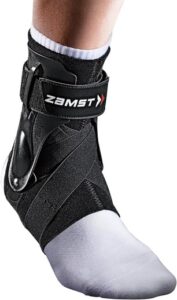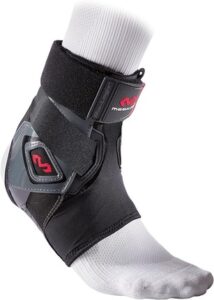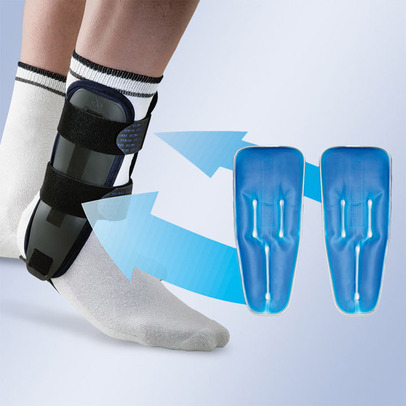When it comes to ankle injuries or chronic ankle instability, finding the right support is crucial. A hinged ankle brace is a valuable tool that provides stability, protection, and helps in the recovery process. In this blog, we will explore the benefits, features, and considerations of hinged ankle braces, shedding light on how they can aid in preventing injuries and facilitating healing.
Table: Best Hinged Ankle Brace Products
1. ARYSE IFAST
The IFAST ankle brace and stabilizer product is designed for athletes who refuse to compromise on protection or performance, this innovative brace defends against ankle injuries without hindering your movement. Focus 100% on your game, leaving concerns about sprains or rolled ankles behind.
Regain confidence in your body, especially if you’re prone to ankle injuries. The IFAST ankle brace acts like an additional set of ligaments, offering superior stabilization and protection. Take control of your movements on the court with the assurance that you are safeguarded against potential injuries.
Don’t let an ankle injury jeopardize your hard-earned progress, scholarship opportunities, or chances to compete. Safeguard your athletic career with the IFAST ankle support. Every step onto the court without IFAST poses the risk of a painful ankle injury, potentially sidelining you and leading to costly surgeries. Invest in protection with IFAST to secure your path to success.
The slim design of the IFAST ankle stabilizer ensures a snug fit without uncomfortable bulkiness. No need to size up or invest in new shoes – maintain your agility and comfort with your favorite pair of athletic shoes. This ankle stabilizer outperforms the competition. Say goodbye to traditional taping, spatting, or ankle support braces that offer limited protection. Other options designed for athletes fall short, leaving you more restricted. Choose IFAST for unparalleled protection and a full range of motion. Price: 74$
2. Zamst A2-DX Sports Ankle Brace
This ankle brace product is a cutting-edge solution for high ankle sprains (Grade III) and chronic ankle instability. Crafted with durable nylon and imported for quality, this brace is designed to reduce inversion and eversion movements, offering targeted protection for the high ankle. The innovative Dual X-Strap Stabilizer ensures three-way support – Anterior, Lateral, and Medial for enhanced stability in the lower ankle. With a left and right specific design, each brace is tailored for a perfect fit. The rear application feature facilitates easy adjustments, making it a breeze to achieve optimal support.
Prioritize your ankle health with Zamst A2-DX, available now for a competitive price. Explore sizing options, place your order, and experience the next level of medical-grade ankle support.
3. McDavid Bio-Logix Ankle Brace
This McDavid Bio-Logix Ankle Brace product is great for addressing various ankle issues, including Achilles tendon discomfort. The design is not only effective but also impressively low-profile and lightweight, thanks to the Biologics engineering. The adjustable elastic ankle wrap ensures a snug fit, and the Flex-link hinge design delivers maximum support while allowing natural body movement. What is the most special is its anatomical specificity for the right or left ankle, catering to both men and women, including teen athletes and larger kids.
The comfort level is exceptional, with Memory Foam Padding around the ankle joint and multiple anchor straps, providing a truly customized and adjustable fit. Plus, with a competitive price of approximately $60, it’s a smart investment in both medical support and overall comfort. The ordering process was seamless, offering various sizing options. If you’re seeking effective pain relief and reliable support for moderate ankle instabilities, we highly recommend adding the McDavid Bio-Logix to your cart for an optimal recovery experience.
About Hinged Ankle Brace
A hinged ankle brace is a type of orthopedic device designed to provide support and stabilization to the ankle joint. It typically consists of a combination of rigid and flexible materials. The “hinged” part refers to the presence of hinges around the ankle, allowing controlled movement while limiting excessive motion.
The main purpose of a hinged ankle brace is to protect the ankle from injuries, provide stability during rehabilitation, and prevent further damage in case of existing injuries. The hinges permit a controlled range of motion, allowing the foot to move within a certain range while restricting excessive side-to-side or front-to-back movement that could lead to sprains or strains.
Hinged ankle braces are commonly used by athletes, individuals recovering from ankle injuries, or those with chronic ankle instability. They come in various designs and may be adjustable to suit different levels of support and comfort. The choice of a hinged ankle brace depends on the specific needs of the individual and the type and severity of the ankle condition or injury.
Health Beneftis of Hinged Ankle Brace

Hinged ankle braces offer several health benefits, particularly for patients who have experienced ankle injuries or suffer from chronic instability. Here are some of the key health benefits associated with using hinged ankle braces:
- Stability and Support:
- Injury Prevention: Hinged ankle braces provide stability to the ankle joint, reducing the risk of injuries such as sprains and strains. They restrict excessive movement that could lead to trauma.
- Rehabilitation:
- Post-Injury Support: Individuals recovering from ankle injuries, such as sprains or fractures, can benefit from hinged ankle braces. The hinges allow for controlled movement, promoting a gradual return to normal activities without compromising the healing process.
- Range of Motion Control:
- Controlled Movement: The hinges in these braces permit a controlled range of motion, allowing natural movement while preventing hyperextension or excessive lateral movement. This can be crucial during the recovery phase.
- Chronic Ankle Instability:
- Management of Instability: For those with chronic ankle instability, hinged ankle braces offer ongoing support. They help compensate for weakened ligaments, reducing the likelihood of recurrent sprains.
- Pain Reduction:
- Pain Management: By providing stability and reducing unwanted movement, hinged ankle braces can help alleviate pain associated with certain ankle conditions or injuries.
- Enhanced Performance:
- Athletic Support: Athletes often use hinged ankle braces to protect against injuries during sports activities. The support they provide can contribute to better performance and confidence in movement.
- Customizable Support:
- Adjustable Fit: Many hinged ankle braces are adjustable, allowing users to customize the level of support based on their specific needs. This adaptability can be particularly beneficial during different stages of recovery.
- Comfort and Compliance:
- User Comfort: The design of hinged ankle braces takes into account user comfort, making it more likely that individuals will wear them consistently, which is essential for effective support and recovery.
What Injuries Does the Hinged Ankle Brace Treat and How Medicine Views Ankle Braces?

Hinged ankle braces are often used in the treatment and prevention of various ankle injuries and conditions. However, their appropriateness for a specific injury may vary, and it’s crucial to consult with a healthcare professional for personalized advice. Here are some common injuries and conditions for which hinged ankle braces may be recommended:
- Ankle Sprains:
- Description: Hinged ankle braces are commonly used to treat and prevent ankle sprains, which involve the stretching or tearing of ligaments.
- Role of Brace: The brace provides stability to the ankle joint, limiting excessive movement and helping to prevent further sprains.
- Ankle Fractures:
- Description: In cases of ankle fractures or breaks, hinged ankle braces can be used during the rehabilitation process.
- Role of Brace: The brace provides support to the healing ankle, helping to control movement and prevent re-injury during the recovery period.
- Chronic Ankle Instability:
- Description: Chronic ankle instability is characterized by recurrent sprains and a feeling of instability in the ankle.
- Role of Brace: Hinged ankle braces offer ongoing support to individuals with chronic instability, helping to improve stability and reduce the risk of future sprains.
- Tendonitis:
- Description: Inflammation of the tendons around the ankle, known as tendonitis, may benefit from the support provided by hinged ankle braces.
- Role of Brace: The brace can help reduce stress on the tendons and provide stability during movement.
- Posterior Tibial Tendon Dysfunction (PTTD):
- Description: PTTD is a condition involving the dysfunction of the posterior tibial tendon, often leading to flatfoot deformity.
- Role of Brace: Hinged ankle braces can assist in supporting the foot and ankle in cases of PTTD.
- Achilles Tendonitis or Tendonosis:
- Description: Inflammation or degeneration of the Achilles tendon.
- Role of Brace: Hinged ankle braces may provide support and help control ankle movement, reducing strain on the Achilles tendon during activities.
- Rehabilitation after Surgery:
- Description: After ankle surgery, hinged ankle braces may be used as part of the rehabilitation process to support healing and controlled movement.
- Role of Brace: The brace helps protect the surgical site and facilitates a gradual return to normal activities.
In general, the use of ankle braces, including hinged ankle braces, is viewed positively in medicine for specific situations. Healthcare professionals may recommend braces as part of a comprehensive treatment plan for ankle injuries or conditions. However, it’s crucial to use braces under the guidance of a healthcare provider, as improper or prolonged use without professional oversight may have potential drawbacks. The goal is to provide appropriate support and stabilization while promoting the natural healing process of the injured or affected area.
Choosing the Right Hinged Ankle Brace
Fit and Comfort: It’s crucial to select a hinged ankle brace that fits well and provides optimal comfort. Look for braces with adjustable straps, padding, and breathable materials to ensure a snug fit without causing discomfort or skin irritations.
Level of Support: The level of support needed will depend on the severity of the injury or the individual’s requirements. Some hinged ankle braces offer varying degrees of support, allowing you to customize the level of stability based on your specific needs.
Quality and Durability: Investing in a high-quality hinged ankle brace is essential for both short-term and long-term use. Look for braces made from durable materials that can withstand repeated use and provide reliable support over an extended period.
Conclusion

A hinged ankle brace is a valuable tool for individuals recovering from ankle injuries or those with chronic instability. It provides the necessary stability, support, and protection required during the healing process while allowing controlled movement for rehabilitation. By choosing the right brace and following proper usage guidelines, individuals can effectively prevent injuries, reduce pain, and restore ankle function. Consult a healthcare professional to determine if a hinged ankle brace is suitable for your specific needs and take the necessary steps towards a safe and successful recovery.
FAQ
- What is a hinged ankle brace, and how does it work? A hinged ankle brace is a specialized orthopedic device designed to provide support, stability, and protection to the ankle joint. It typically includes adjustable hinges or rigid support structures that limit excessive side-to-side or rotational movements while allowing controlled and safe movement. The brace helps stabilize the ankle, reducing the risk of further injury and promoting healing.
- When should I use a hinged ankle brace? You should consider using a hinged ankle brace if you have a history of ankle injuries, chronic ankle instability, or are recovering from an ankle sprain or strain. Additionally, if you participate in activities or sports that involve rapid direction changes or have a higher risk of ankle injuries, wearing a hinged ankle brace can provide preventive support. Consult with a healthcare professional to determine if a hinged ankle brace is appropriate for your specific condition.
- How do I choose the right hinged ankle brace? Choosing the right hinged ankle brace involves considering factors such as fit, comfort, level of support, and durability. Look for a brace that fits well and provides a snug yet comfortable fit. Adjustable straps, padding, and breathable materials contribute to overall comfort. The level of support needed may vary based on your condition, so select a brace that offers appropriate stability. It’s essential to invest in a high-quality brace made from durable materials to ensure long-lasting support.
- Can I wear a hinged ankle brace during physical activities or sports? Yes, hinged ankle braces are designed to be worn during physical activities and sports. They provide support and stability, reducing the risk of injury during dynamic movements. However, it’s important to check with a healthcare professional to determine the specific recommendations for wearing the brace during different activities. In some cases, they may suggest removing or adjusting the brace for certain sports or exercises.
- Can I wear a hinged ankle brace with my shoes? Most hinged ankle braces are designed to be worn with shoes, but the compatibility may vary depending on the brace and shoe type. It’s advisable to choose low-profile braces that fit comfortably inside your shoes without causing discomfort or hindering proper shoe fit. Certain hinged ankle braces may require wearing shoes with a wider toe box or specific features to accommodate the brace. Consider trying on the brace with your shoes to ensure a proper fit and compatibility.

